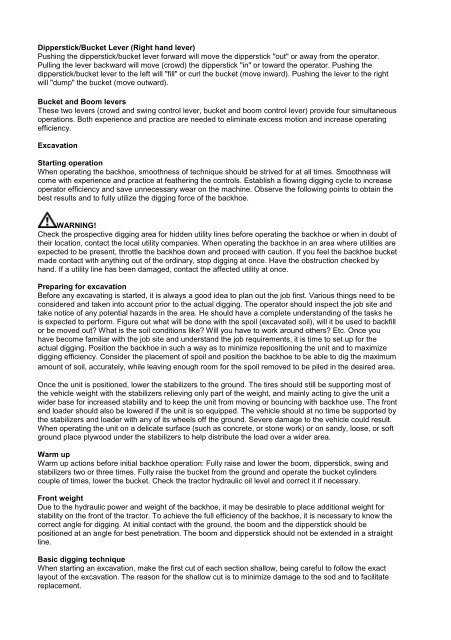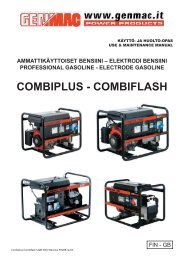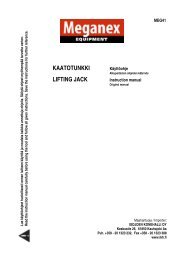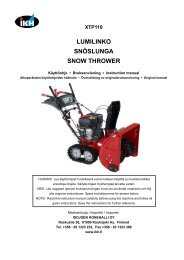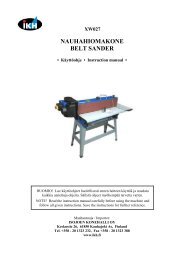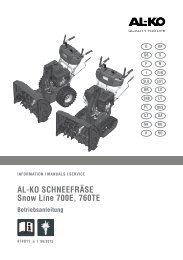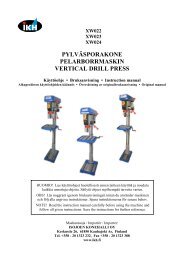INSTRUCTION MANUAL - Virtasenkauppa.fi
INSTRUCTION MANUAL - Virtasenkauppa.fi
INSTRUCTION MANUAL - Virtasenkauppa.fi
Create successful ePaper yourself
Turn your PDF publications into a flip-book with our unique Google optimized e-Paper software.
Dipperstick/Bucket Lever (Right hand lever)<br />
Pushing the dipperstick/bucket lever forward will move the dipperstick "out" or away from the operator.<br />
Pulling the lever backward will move (crowd) the dipperstick "in" or toward the operator. Pushing the<br />
dipperstick/bucket lever to the left will "<strong>fi</strong>ll" or curl the bucket (move inward). Pushing the lever to the right<br />
will "dump" the bucket (move outward).<br />
Bucket and Boom levers<br />
These two levers (crowd and swing control lever, bucket and boom control lever) provide four simultaneous<br />
operations. Both experience and practice are needed to eliminate excess motion and increase operating<br />
ef<strong>fi</strong>ciency.<br />
Excavation<br />
Starting operation<br />
When operating the backhoe, smoothness of technique should be strived for at all times. Smoothness will<br />
come with experience and practice at feathering the controls. Establish a flowing digging cycle to increase<br />
operator ef<strong>fi</strong>ciency and save unnecessary wear on the machine. Observe the following points to obtain the<br />
best results and to fully utilize the digging force of the backhoe.<br />
WARNING!<br />
Check the prospective digging area for hidden utility lines before operating the backhoe or when in doubt of<br />
their location, contact the local utility companies. When operating the backhoe in an area where utilities are<br />
expected to be present, throttle the backhoe down and proceed with caution. If you feel the backhoe bucket<br />
made contact with anything out of the ordinary, stop digging at once. Have the obstruction checked by<br />
hand. If a utility line has been damaged, contact the affected utility at once.<br />
Preparing for excavation<br />
Before any excavating is started, it is always a good idea to plan out the job <strong>fi</strong>rst. Various things need to be<br />
considered and taken into account prior to the actual digging. The operator should inspect the job site and<br />
take notice of any potential hazards in the area. He should have a complete understanding of the tasks he<br />
is expected to perform. Figure out what will be done with the spoil (excavated soil), will it be used to back<strong>fi</strong>ll<br />
or be moved out What is the soil conditions like Will you have to work around others Etc. Once you<br />
have become familiar with the job site and understand the job requirements, it is time to set up for the<br />
actual digging. Position the backhoe in such a way as to minimize repositioning the unit and to maximize<br />
digging ef<strong>fi</strong>ciency. Consider the placement of spoil and position the backhoe to be able to dig the maximum<br />
amount of soil, accurately, while leaving enough room for the spoil removed to be piled in the desired area.<br />
Once the unit is positioned, lower the stabilizers to the ground. The tires should still be supporting most of<br />
the vehicle weight with the stabilizers relieving only part of the weight, and mainly acting to give the unit a<br />
wider base for increased stability and to keep the unit from moving or bouncing with backhoe use. The front<br />
end loader should also be lowered if the unit is so equipped. The vehicle should at no time be supported by<br />
the stabilizers and loader with any of its wheels off the ground. Severe damage to the vehicle could result.<br />
When operating the unit on a delicate surface (such as concrete, or stone work) or on sandy, loose, or soft<br />
ground place plywood under the stabilizers to help distribute the load over a wider area.<br />
Warm up<br />
Warm up actions before initial backhoe operation: Fully raise and lower the boom, dipperstick, swing and<br />
stabilizers two or three times. Fully raise the bucket from the ground and operate the bucket cylinders<br />
couple of times, lower the bucket. Check the tractor hydraulic oil level and correct it if necessary.<br />
Front weight<br />
Due to the hydraulic power and weight of the backhoe, it may be desirable to place additional weight for<br />
stability on the front of the tractor. To achieve the full ef<strong>fi</strong>ciency of the backhoe, it is necessary to know the<br />
correct angle for digging. At initial contact with the ground, the boom and the dipperstick should be<br />
positioned at an angle for best penetration. The boom and dipperstick should not be extended in a straight<br />
line.<br />
Basic digging technique<br />
When starting an excavation, make the <strong>fi</strong>rst cut of each section shallow, being careful to follow the exact<br />
layout of the excavation. The reason for the shallow cut is to minimize damage to the sod and to facilitate<br />
replacement.


